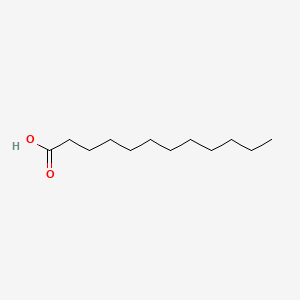| MeSH term | MeSH ID | Detail |
|---|---|---|
| Hemolysis | D006461 | 131 associated lipids |
| Neovascularization, Pathologic | D009389 | 39 associated lipids |
| Lung Neoplasms | D008175 | 171 associated lipids |
| Colonic Neoplasms | D003110 | 161 associated lipids |
| Diabetes Mellitus, Experimental | D003921 | 85 associated lipids |
| Body Weight | D001835 | 333 associated lipids |
| Acne Vulgaris | D000152 | 35 associated lipids |
| Hypersensitivity, Delayed | D006968 | 43 associated lipids |
| Liver Neoplasms, Experimental | D008114 | 46 associated lipids |
| Thrombosis | D013927 | 49 associated lipids |
lauric acid
lauric acid is a lipid of Fatty Acyls (FA) class. Lauric acid is associated with abnormalities such as Infection, Renal tubular disorder, Hypertensive disease, Obesity and Mycoses. The involved functions are known as Transcription, Genetic, Signal Transduction, Mutation, metaplastic cell transformation and Anabolism. Lauric acid often locates in Skin, Plasma membrane, Cytoplasmic matrix, Body tissue and Palmar surface. The associated genes with lauric acid are Gene Family, SLC33A1 gene, Homologous Gene, Open Reading Frames and P4HTM gene. The related lipids are Fatty Acids, Oleic Acids, Palmitates, Stearates and 9,11-linoleic acid.
Cross Reference
Introduction
To understand associated biological information of lauric acid, we collected biological information of abnormalities, associated pathways, cellular/molecular locations, biological functions, related genes/proteins, lipids and common seen animal/experimental models with organized paragraphs from literatures.
What diseases are associated with lauric acid?
lauric acid is suspected in Renal tubular disorder, Hypertensive disease, Infection, Renal vascular disorder, Obesity, Mycoses and other diseases in descending order of the highest number of associated sentences.
Related references are mostly published in these journals:
- Am. J. Clin. Nutr. (1)
- Am. J. Physiol. Heart Circ. Physiol. (1)
- Antimicrob. Agents Chemother. (1)
- Others (7)
| Disease | Cross reference | Weighted score | Related literature |
|---|
Possible diseases from mapped MeSH terms on references
We collected disease MeSH terms mapped to the references associated with lauric acid
PubChem Associated disorders and diseases
What pathways are associated with lauric acid
There are no associated biomedical information in the current reference collection.
PubChem Biomolecular Interactions and Pathways
Link to PubChem Biomolecular Interactions and PathwaysWhat cellular locations are associated with lauric acid?
Visualization in cellular structure
Associated locations are in red color. Not associated locations are in black.
Related references are published most in these journals:
| Location | Cross reference | Weighted score | Related literatures |
|---|
What functions are associated with lauric acid?
Related references are published most in these journals:
| Function | Cross reference | Weighted score | Related literatures |
|---|
What lipids are associated with lauric acid?
Related references are published most in these journals:
| Lipid concept | Cross reference | Weighted score | Related literatures |
|---|
What genes are associated with lauric acid?
Related references are published most in these journals:
| Gene | Cross reference | Weighted score | Related literatures |
|---|
What common seen animal models are associated with lauric acid?
There are no associated biomedical information in the current reference collection.
NCBI Entrez Crosslinks
All references with lauric acid
Download all related citations| Authors | Title | Published | Journal | PubMed Link |
|---|---|---|---|---|
| Mangeat B et al. | HIV-1 Vpu neutralizes the antiviral factor Tetherin/BST-2 by binding it and directing its beta-TrCP2-dependent degradation. | 2009 | PLoS Pathog. | pmid:19730691 |
| Ittig S et al. | The lipopolysaccharide from Capnocytophaga canimorsus reveals an unexpected role of the core-oligosaccharide in MD-2 binding. | 2012 | PLoS Pathog. | pmid:22570611 |
| Munford RS and Varley AW | Shield as signal: lipopolysaccharides and the evolution of immunity to gram-negative bacteria. | 2006 | PLoS Pathog. | pmid:16846256 |
| Wexler-Cohen Y and Shai Y | Membrane-anchored HIV-1 N-heptad repeat peptides are highly potent cell fusion inhibitors via an altered mode of action. | 2009 | PLoS Pathog. | pmid:19593361 |
| Ponton F et al. | Nutritional immunology: a multi-dimensional approach. | 2011 | PLoS Pathog. | pmid:22144886 |
| Katsikis PD et al. | The cytokine network of acute HIV infection: a promising target for vaccines and therapy to reduce viral set-point? | 2011 | PLoS Pathog. | pmid:21852945 |
| Zhou Z et al. | HIV-1 efficient entry in inner foreskin is mediated by elevated CCL5/RANTES that recruits T cells and fuels conjugate formation with Langerhans cells. | 2011 | PLoS Pathog. | pmid:21738469 |
| Nawaz F et al. | The genotype of early-transmitting HIV gp120s promotes α (4) β(7)-reactivity, revealing α (4) β(7) +/CD4+ T cells as key targets in mucosal transmission. | 2011 | PLoS Pathog. | pmid:21383973 |
| Lepelley A et al. | Innate sensing of HIV-infected cells. | 2011 | PLoS Pathog. | pmid:21379343 |
| Li H et al. | High Multiplicity Infection by HIV-1 in Men Who Have Sex with Men. | 2010 | PLoS Pathog. | pmid:20485520 |
